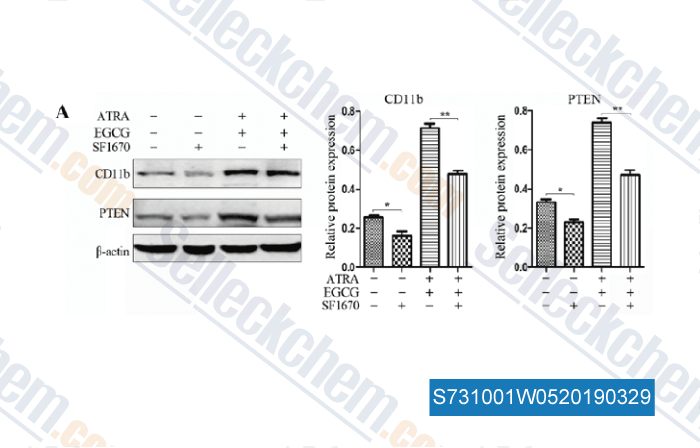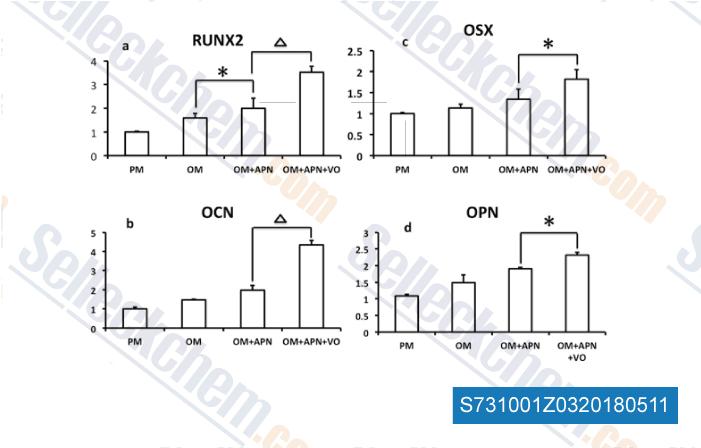|
Toll Free: (877) 796-6397 -- USA and Canada only -- |
Fax: +1-832-582-8590 Orders: +1-832-582-8158 |
Tech Support: +1-832-582-8158 Ext:3 Please provide your Order Number in the email. |
Technical Data
| Formula | C19H17NO3 |
||||||
| Molecular Weight | 307.34 | CAS No. | 345630-40-2 | ||||
| Solubility (25°C)* | In vitro | DMSO | 29 mg/mL (94.35 mM) | ||||
| Ethanol | 1 mg/mL (3.25 mM) | ||||||
| Water | Insoluble | ||||||
| In vivo (Add solvents to the product individually and in order) |
|
||||||
|
* <1 mg/ml means slightly soluble or insoluble. * Please note that Selleck tests the solubility of all compounds in-house, and the actual solubility may differ slightly from published values. This is normal and is due to slight batch-to-batch variations. * Room temperature shipping (Stability testing shows this product can be shipped without any cooling measures.) |
|||||||
Preparing Stock Solutions
Biological Activity
| Description | SF1670 is a highly potent and specific PTEN inhibitor with IC50 of 2 μM. | ||
|---|---|---|---|
| Targets |
|
||
| In vitro | SF1670 shows potent cytotoxicity in HBEC, PC-3, H1299 cells with IC50 of 5 μM, 10 μM, 44 μM, respectively. In a mouse aortic ring matrigel angiogenesis model, SF1670 stimulates the angiogenic processes. [1] SF1670 augments chemoattractant-elicited PtdIns(3,4,5)P3 signaling in neutrophils and enhances neutrophil functions. [2] | ||
| In vivo | Pretreatment of SF1670 (500 nM i.v.) augments bacteria-killing capability in neutropenic mice in both peritonitis and bacterial pneumonia, and decreases the mortality of neutropenia-related pneumonia. [2] |
Protocol (from reference)
| Kinase Assay:[1] |
|
|---|---|
| Cell Assay:[1] |
|
| Animal Study:[2] |
|
References
|
|
Customer Product Validation

-
Data from [Data independently produced by , , Int J Oncol, 2017, 51(3):899-906]

-
Data from [Data independently produced by , , Biochem Biophys Res Commun, 2017, 483(1):712-717]
Selleck's SF1670 has been cited by 26 publications
| Heterogeneity-driven phenotypic plasticity and treatment response in branched-organoid models of pancreatic ductal adenocarcinoma [ Nat Biomed Eng, 2024, 10.1038/s41551-024-01273-9] | PubMed: 39658630 |
| African swine fever virus infection regulates pyroptosis by cleaving gasdermin A (GSDMA) via active caspase-3 and caspase-4 [ J Biol Chem, 2024, S0021-9258(24)01808-8] | PubMed: 38657868 |
| TAN (tannic acid) inhibits BPA-induced pyroptosis of L8824 (grass carp hepatocytes) by regulating PTEN/PI3K/AKT pathway [ Fish Shellfish Immunol, 2024, 146:109384] | PubMed: 38246267 |
| Nicotine Decreases Nerve Regeneration and Pain Behaviors via PTEN and Downstream Inflammation-Related Pathway in Two Rat Nerve Injury Models [ eNeuro, 2023, 10(9)ENEURO.0185-23.2023] | PubMed: 37620149 |
| Nicotine Decreases Nerve Regeneration and Pain Behaviors via PTEN and Downstream Inflammation-Related Pathway in Two Rat Nerve Injury Models [ eNeuro, 2023, 10(9)ENEURO.0185-23.2023] | PubMed: 37620149 |
| PTEN/AKT signaling pathway related to hTERT downregulation and telomere shortening induced in Toxoplasma GRA16-expressing colorectal cancer cells [ Biomed Pharmacother, 2022, 153:113366] | PubMed: 35810694 |
| Formononetin inhibits IL-1β-induced inflammation in human chondrocytes and slows the progression of osteoarthritis in rat model via the regulation of PTEN/AKT/NF-κB pathway [ Int Immunopharmacol, 2022, 113(Pt A):109309] | PubMed: 36306560 |
| Assessment of Alveolar Macrophage Dysfunction Using an in vitro Model of Acute Respiratory Distress Syndrome [ Front Med (Lausanne), 2021, 8:737859] | PubMed: 34660643 |
| Exosomal miR-10b-5p mediates cell communication of gastric cancer cells and fibroblasts and facilitates cell proliferation [ J Cancer, 2021, 12(7):2140-2150] | PubMed: 33754012 |
| Three paralogous clusters of the miR-17~92 family of microRNAs restrain IL-12-mediated immune defense. [ Cell Mol Immunol, 2020, 10.1038/s41423-020-0363-5] | PubMed: 32015501 |
RETURN POLICY
Selleck Chemical’s Unconditional Return Policy ensures a smooth online shopping experience for our customers. If you are in any way unsatisfied with your purchase, you may return any item(s) within 7 days of receiving it. In the event of product quality issues, either protocol related or product related problems, you may return any item(s) within 365 days from the original purchase date. Please follow the instructions below when returning products.
SHIPPING AND STORAGE
Selleck products are transported at room temperature. If you receive the product at room temperature, please rest assured, the Selleck Quality Inspection Department has conducted experiments to verify that the normal temperature placement of one month will not affect the biological activity of powder products. After collecting, please store the product according to the requirements described in the datasheet. Most Selleck products are stable under the recommended conditions.
NOT FOR HUMAN, VETERINARY DIAGNOSTIC OR THERAPEUTIC USE.
